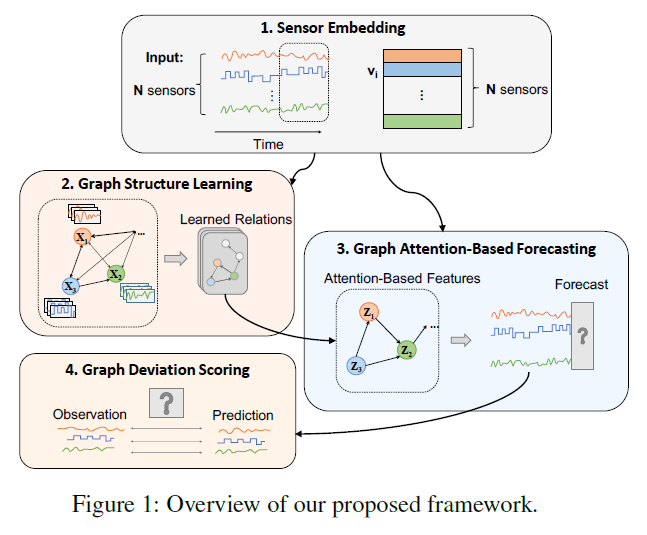GNN-based Anomaly Detection in MTS (2021, 32)
Contents
- Abstract
- Introduction
- Proposed Framework
- Sensor Embedding
- Graph Structure Learning
- Graph Attention-based Forecasting
- Graph Deviation Scoring
0. Abstract
proposes GDN (Graph Deviation Network)
- combines a “structure learning approach” with GNN
- use attention weights to provide explainability
1. Introduction
GDP (Graph Deviation Network)
- 1) learns a graph of relationships between sensors
- 2) detects deviations from these patterns
4 components
- 1) Sensor Embedding
- capture unique characteristics of each sensor
- 2) Graph Structure Learning
- learns relationship
- 3) Graph Attention-based Forecasting
- predict future values
- 4) Graph Deviation Scoring
- identifies & explains deviations
2. Proposed Framework
Problem Statement
Train data :
- \(\mathrm{s}_{\text {train }}=\left[\mathrm{s}_{\text {train }}^{(1)}, \cdots, \mathrm{s}_{\text {train }}^{\left(T_{\text {train }}\right)}\right]\).
Test data :
- \(\left[\mathrm{s}_{\text {test }}^{(1)}, \cdots, \mathrm{s}_{\text {test }}^{\left(T_{\text {test }}\right)}\right]\).
Notation
- \(N\) : # of TS (sensors)
- \(\mathrm{a}(t) \in\{0,1\}\) : whether it is anomaly or not

(1) Sensor Embedding
GOAL : represent each sensor in a flexible way
Embedding vector :
- \(\mathbf{v}_{\mathbf{i}} \in \mathbb{R}^{d}, \text { for } i \in\{1,2, \cdots, N\}\).
Details
- similar embedding = high tendency to be related
- use these embeddings in..
- 1) structure learning
- which sensors are related to one another
- 2) attention mechanism
- over neighbors
- 1) structure learning
(2) Graph Structure Learning
Use “DIRECTED” graph
- sensor A is used for modeling the behavior of sensor B
Can be used in both case..
- 1) case 1 : NO prior information
- 2) case 2 : SOME prior information
about edges
Prior information
-
represented as a set of “candidate relations \(\mathcal{C}_i\) “ for each sensor
- \(\mathcal{C}_{i} \subseteq\{1,2, \cdots, N\} \backslash\{i\}\).
-
compute the similarity between node \(i\)’s embedding vetor
& embeddings of its candidates \(j \in \mathcal{C_i}\)
- \(e_{j i} =\frac{\mathbf{v}_{\mathbf{i}}^{\top} \mathbf{v}_{\mathbf{j}}}{ \mid \mid \mathbf{v}_{\mathbf{i}} \mid \mid \cdot \mid \mid \mathbf{v}_{\mathbf{j}} \mid \mid } \text { for } j \in \mathcal{C}_{i}\).
- \(A_{j i} =\mathbb{1}\left\{j \in \operatorname{Top} \mathrm{K}\left(\left\{e_{k i}: k \in \mathcal{C}_{i}\right\}\right)\right\}\).
- \(k\) denotes sparsity level
With “learned adjacency matrix”, send it to graph attention-based model
(3) Graph Attention-based Forecasting
use “forecasting-based” approach
Notation
- input ( at time \(t\) ) = \(\mathbf{x}^{(t)} \in \mathbb{R}^{N \times w}\)
- \(w\) : window size
- \(\mathrm{x}^{(t)}:=\left[\mathrm{s}^{(\mathrm{t}-\mathrm{w})}, \mathrm{s}^{(\mathrm{t}-\mathrm{w}+1)}, \cdots, \mathrm{s}^{(\mathrm{t}-1)}\right]\).
- predict \(\mathrm{s}^{(\mathrm{t})}\)
a) Feature Extractor
- GAT based feature extractor
- incorporates the sensor embedding vectors \(\mathbf{v}_{i}\)
- node \(i\)’s aggregated representation : \(\mathbf{z}_{i}^{(t)}\).
- \(\mathbf{z}_{i}^{(t)}=\operatorname{ReLU}\left(\alpha_{i, i} \mathbf{W} \mathbf{x}_{i}^{(t)}+\sum_{j \in \mathcal{N}(i)} \alpha_{i, j} \mathbf{W} \mathbf{x}_{j}^{(t)}\right)\).
- \(\mathcal{N}(i)=\left\{j \mid A_{j i}>0\right\}\) : set of neighbors
- \(\mathbf{g}_{i}^{(t)}=\mathbf{v}_{i} \oplus \mathbf{W} \mathbf{x}_{i}^{(t)}\).
- \(\pi(i, j) =\text { LeakyReLU }\left(\mathbf{a}^{\top}\left(\mathbf{g}_{i}^{(t)} \oplus \mathbf{g}_{j}^{(t)}\right)\right)\).
- \(\alpha_{i, j} =\frac{\exp (\pi(i, j))}{\sum_{k \in \mathcal{N}(i) \cup\{i\}} \exp (\pi(i, k))}\).
- \(\mathbf{z}_{i}^{(t)}=\operatorname{ReLU}\left(\alpha_{i, i} \mathbf{W} \mathbf{x}_{i}^{(t)}+\sum_{j \in \mathcal{N}(i)} \alpha_{i, j} \mathbf{W} \mathbf{x}_{j}^{(t)}\right)\).
- representation of all nodes :
- \(\left\{\mathbf{z}_{1}^{(t)}, \cdots, \mathbf{z}_{N}^{(t)}\right\}\).
b) Output Layer
Predict vector of sensor values (at time \(t\)) : \(\mathrm{s}^{(\mathrm{t})}\)
- \(\hat{\mathbf{s}}^{(\mathbf{t})}=f_{\theta}\left(\left[\mathbf{v}_{1} \circ \mathbf{z}_{1}^{(t)}, \cdots, \mathbf{v}_{N} \circ \mathbf{z}_{N}^{(t)}\right]\right)\).
Loss Function :
- \(L_{\mathrm{MSE}}=\frac{1}{T_{\text {train }}-w} \sum_{t=w+1}^{T_{\text {train }}} \mid \mid \hat{\mathbf{s}}^{(\mathrm{t})}-\mathrm{s}^{(\mathrm{t})} \mid \mid _{2}^{2}\).
(4) Graph Deviation Scoring
- detect & explain anomalies
- anomalousness score :
- \(\operatorname{Err}_{i}(t)= \mid \mathbf{s}_{\mathbf{i}}^{(\mathbf{t})}-\hat{\mathbf{s}}_{\mathbf{i}}^{(\mathbf{t})} \mid\).
- robust normalization
- \(a_{i}(t)=\frac{\operatorname{Err}_{i}(t)-\widetilde{\mu}_{i}}{\widetilde{\sigma}_{i}}\).
- \(\widetilde{\mu}_{i}\) : median
- \({\widetilde{\sigma}_{i}}\) : inter-quartile range
- \(a_{i}(t)=\frac{\operatorname{Err}_{i}(t)-\widetilde{\mu}_{i}}{\widetilde{\sigma}_{i}}\).
- overall anomalousness ( at time \(t\) )
- \(A(t)=\max _{i} a_{i}(t)\).
- simple moving average (SMA) to generate the “smoothed scores \(A_s(t)\)”
